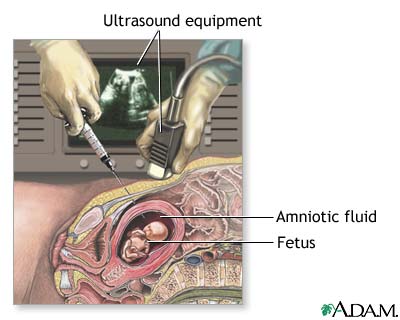Amniocentesis - series
Procedure, part 1

Amniocentesis is done in an examination room, either with or without local anesthesia. It typically takes just a few minutes, during which you must lie very still. A technician locates your fetus with an ultrasound. Using the ultrasound for guidance, your doctor carefully inserts a long, but thin, hollow needle through your abdomen and into the amniotic sac. You should receive Rh immune globulin (RHIG) at the time of amniocentesis if you are an Rh-negative unsensitized patient.
Update Date: 9/13/2011
Updated by: Linda J. Vorvick, MD, Medical Director, MEDEX Northwest Division of Physician Assistant Studies, University of Washington, School of Medicine; Susan Storck, MD, FACOG, Chief, Eastside Department of Obstetrics and Gynecology, Group Health Cooperative of Puget Sound, Bellevue, Washington; Clinical Teaching Faculty, Department of Obstetrics and Gynecology, University of Washington School of Medicine. Also reviewed by David Zieve, MD, MHA, Medical Director, A.D.A.M., Inc.
Related Page
Notice: The information provided herein should not be used during any medical emergency or for the diagnosis or treatment of any medical condition. A licensed physician should be consulted for diagnosis and treatment of any and all medical conditions. Call 911 for all medical emergencies. Links to other sites are provided for information only -- they do not constitute endorsements of those other sites. Copyright 1997-2012, A.D.A.M., Inc. Any duplication or distribution of the information contained herein is strictly prohibited.
